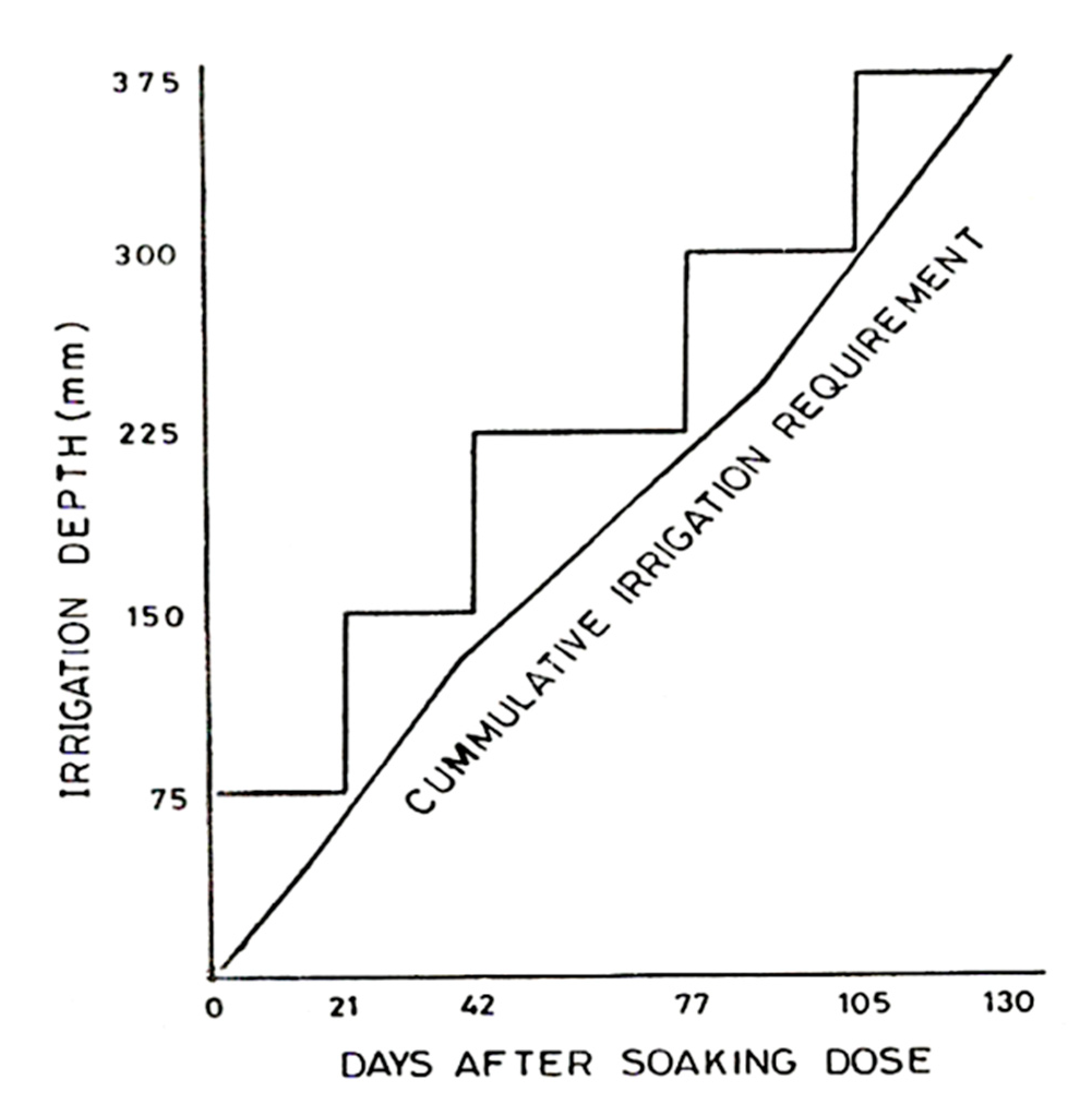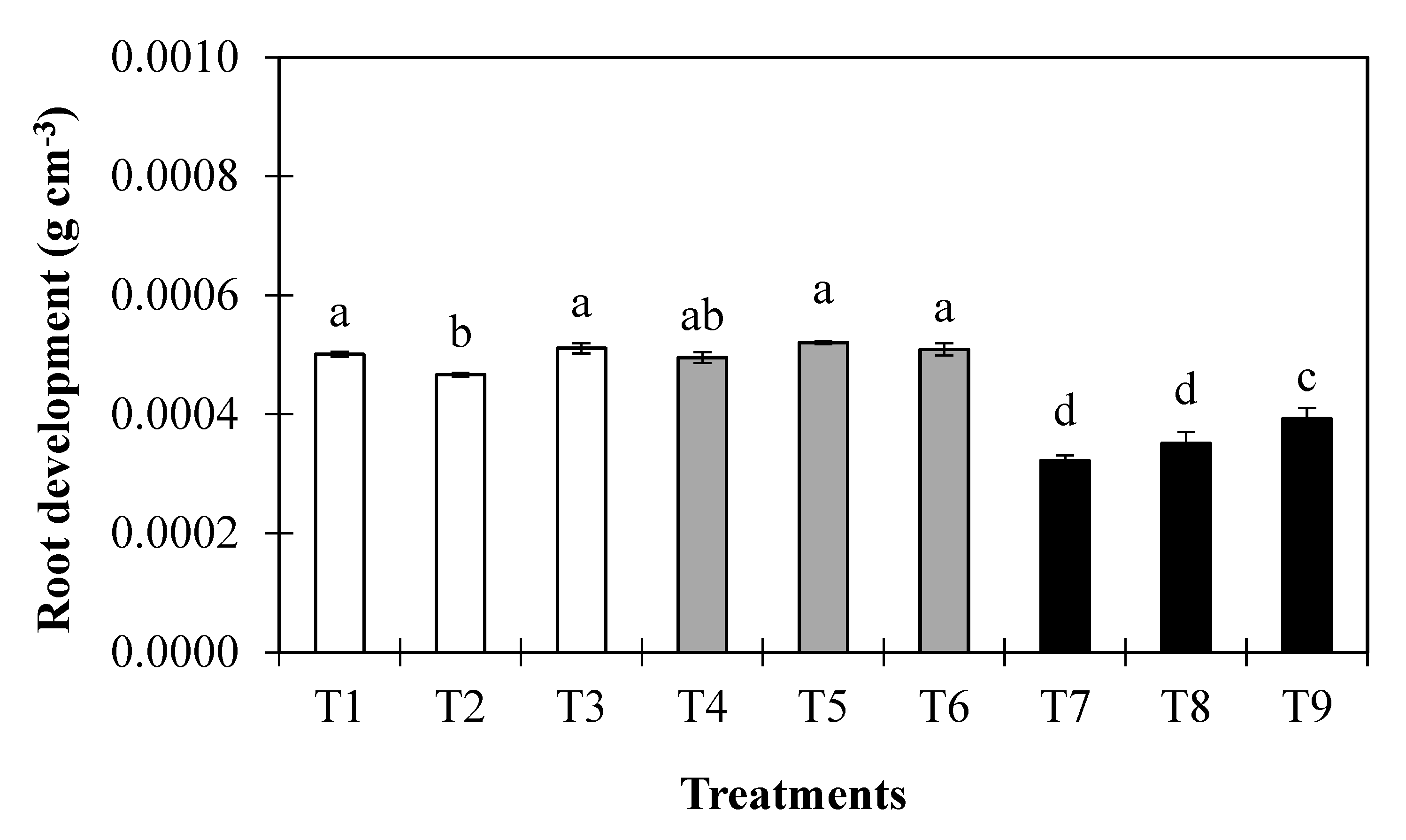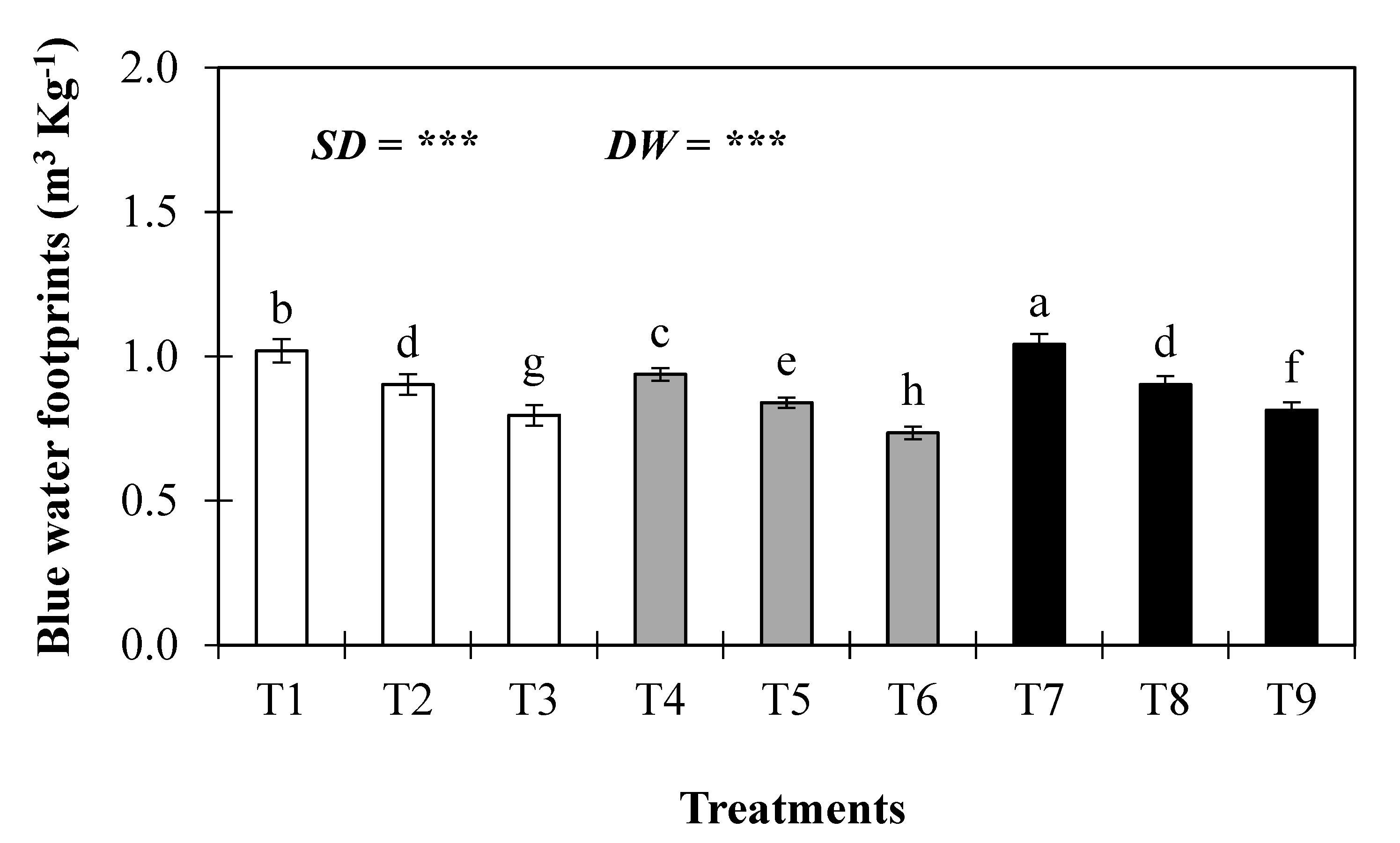Effect of Sowing Time Variations and Irrigation Water Levels on Growth, Yield of Wheat, and Water Footprints
Abstract
1. Introduction
2. Materials and Methods
2.1. Treatment and Arrangement
- Factor-A: Sowing time variations = 03
- SD1 = 15 days in advance
- SD2 = Normal sowing time (actual sowing time of 1st November in the local field)
- SD3 = 15 days in delay
- Factor-B: Irrigation water levels = 03
- CW = Control water (existing irrigation practice 75 mm)
- DW1 = Deficit water (15% deficit existing irrigation practice at each irrigation (63.75 mm))
- DW2 = Deficit water (30% deficit existing irrigation practice at each irrigation (52.5 mm))
| Sowing Time | Irrigation Water Levels | Treatments |
|---|---|---|
| Factor-A | Factor-B | |
| SD1 | CW | T1 |
| DW1 | T2 | |
| DW2 | T3 | |
| SD2 | CW | T4 |
| DW1 | T5 | |
| DW2 | T6 | |
| SD3 | CW | T7 |
| DW1 | T8 | |
| DW2 | T9 |
2.2. Land Preparation, Cultural Practices, and Soil Water Properties
2.3. Irrigation Plan and Measurement
2.4. Measurement and Analysis
3. Results
3.1. Plant Height and Spike Length
3.2. Test Weight, Dry Biomass, and Grain Yield
3.3. Root Development
3.4. Plant Level WUE and Water Footprints
3.5. Economic Cost
4. Discussion
5. Conclusions
Author Contributions
Funding
Data Availability Statement
Conflicts of Interest
References
- Vinke, K.; Martin, M.A.; Adams, S.; Baarsch, F.; Bondeau, A.; Coumou, D.; Svirejeva-Hopkins, A. Climatic Risks and Impacts in South Asia: Extremes of Water Scarcity and Excess. Reg. Environ. Change 2017, 17, 1569–1583. [Google Scholar] [CrossRef]
- Sharma, K.L.; Sharma, S.C.; Bawa, S.S.; Singh, S.; Chandrika, D.S.; Sharma, V.; Khokhar, A.; Grace, J.K.; Rao, C.S.; Sankar, G.R.M.; et al. Combined Effect of Tillage and Organic Fertilization on Soil Quality Key Indicators and Indices in Alluvial Soils of Indo-Gangetic Plains under Rainfed Maize–Wheat System. Arch. Agrono. Soil Sci. 2015, 61, 313–327. [Google Scholar] [CrossRef]
- Grindle, A.K.; Siddiqi, A.; Anadon, L.D. Food Security Amidst Water Scarcity: Insights on Sustainable Food Production from Saudi Arabia. Sustain. Prod. Cons. 2015, 2, 67–78. [Google Scholar]
- Mekonnen, M.M.; Hoekstra, A.Y. The Green, Blue and Grey Water Footprint of Crops and Derived Crop Products. Hydrol. Earth Syst. Sci. 2011, 15, 1577–1600. [Google Scholar] [CrossRef]
- Govere, S.; Nyamangara, J.; Nyakatawa, E.Z. Climate Change Signals in The Historical Water Footprint of Wheat Production in Zimbabwe. Sci. Total Environ. 2020, 742, 140473. [Google Scholar] [CrossRef] [PubMed]
- Bokhari, S.A.A.; Rasul, G.; Ruane, A.C.; Hoogenboom, G.; Ahmad, A. The Past and Future Changes in Climate of The Rice-Wheat Cropping Zone in Punjab, Pakistan. Pak. J. Meteorol. 2017, 13, 9–23. [Google Scholar]
- Bana, R.S.; Sepat, S.; Rana, K.S.; Pooniya, V.; Choudhary, A.K. Moisture-Stress Management Under Limited and Assured Irrigation Regimes in Wheat (Triticum aestivum): Effects on Crop Productivity, Water Use Efficiency, Grain Quality, Nutrient Acquisition and Soil Fertility. Indian J. Agric. Sci. 2018, 88, 1606–1612. [Google Scholar] [CrossRef]
- Mishra, A.; Singh, R.; Raghuwanshi, N.S.; Chatterjee, C.; Froebrich, J. Spatial Variability of Climate Change Impacts on Yield af Rice and Wheat in the Indian Ganga Basin. Sci. Total Environ. 2013, 468, S132–S138. [Google Scholar] [CrossRef]
- Lal, M.K.; Tiwari, R.K.; Gahlaut, V.; Mangal, V.; Kumar, A.; Singh, M.P.; Paul, V.; Kumar, S.; Singh, B.; Zinta, G. Physiological and Molecular Insights on Wheat Responses to Heat Stress. Plant Cell Rep. 2021, 41, 501–518. [Google Scholar] [CrossRef] [PubMed]
- Pathania, R.; Prasad, R.; Rana, R.S.; Mishra, S.; Sharma, S. Growth and Yield of Wheat as Influenced by Dates of Sowing and Varieties in Northwestern Himalayas. J. Pharmacogn. Phytochem. 2018, 7, 517–520. [Google Scholar]
- Suryavanshi, P.; Buttar, G.S. Mitigating Terminal Heat Stress in Wheat. Int. J. Bio-Resour. Stress Manag. 2016, 7, 142–150. [Google Scholar] [CrossRef]
- Dubey, R.; Pathak, H.; Singh, S.; Chakravarti, B.; Thakur, A.K.; Fagodia, R.K. Impact of Sowing Dates on Terminal Heat Tolerance of Different Wheat (Triticum aestivum L.) Cultivars. Natl. Acad. Sci. Lett. 2019, 42, 445–449. [Google Scholar] [CrossRef]
- Soothar, R.K.; Wang, C.; Li, L.; Cui, N.; Zhang, W.; Wang, Y. Soil Salt Accumulation and Crop Physiological Responses of Winter Wheat to Supplementary Alternate Irrigation with Saline and Fresh Water at Different Crop Growth Stages in the NCP. J. Soil Sci. Plant Nutr. 2021, 21, 2072–2082. [Google Scholar] [CrossRef]
- Soothar, R.K.; Zhang, W.; Liu, B.; Tankari, M.; Wang, C.; Li, L.; Xing, H.; Gong, D.; Wang, Y. Sustaining Yield of Winter Wheat under Alternate Irrigation using Saline Water at Different Growth Stages: A Case Study in the North China Plain. Sustainability 2019, 11, 4564. [Google Scholar] [CrossRef]
- Katohar, I.; Soothar, R.K.; Chandio, F.A.; Talpur, M.A.; Soomro, S.A.; Singha, A.; Bin, L.; Mirjat, M.U. Drought Priming and Subsequent Irrigation Water Regimes Enhanced Grain Yield and Water Productivity of Wheat Crop. Water 2023, 15, 3704. [Google Scholar] [CrossRef]
- Soulé, A.M.; Mansur, A.B.; Mainassara, Z.A.; Salami, I.; Souley, S. Effect of Sowing Date and Irrigation Frequency on Wheat (Triticum aestivium L.) Production in Southern Niger Republic. J. Agric. Ecol. Res. Int. 2024, 25, 12–20. [Google Scholar] [CrossRef]
- Fazily, T.; Habibi, A. Performance of Wheat Varieties under Different Dates of Sowing under Irrigated Condition of Baghlan Province, Afghanistan. Int. J. Emerg. Technol. Innov. Res. 2019, 6, 50–53. [Google Scholar]
- Baloch, S.U.; Li-Jun, L.I.U.; Kandhroo, M.N.; Fahad, S.; Sabiel, S.A.; Baloch, S.K.; Badini, S.A. Effect of Different Irrigation Schedules on The Growth and Yield Performance of Wheat (Triticum aestivum L.) Varieties Assessment in District Awaran (Balochistan). J. Biol. Agric. Healthc. 2014, 4, 5–17. [Google Scholar]
- Zhang, X.; Qin, W.; Chen, S.; Shao, L.; Sun, H. Responses of Yield and WUE of Winter Wheat to Water Stress During the Past Three Decades—A Case Study in the North China Plain. Agric. Water Manag. 2017, 179, 47–54. [Google Scholar] [CrossRef]
- Iqbal, R.; Andersen, M.N.; Raza, M.A.S.; Rashid, M.A.; Salman, A. Physiological Manipulation and Yield Response of Wheat Grown with Split Root System under Deficit Irrigation. Pak. J. Agric. Res. 2019, 32, 514. [Google Scholar] [CrossRef]
- Foulkes, M.J.; Slafer, G.A.; Davies, W.J.; Berry, P.M.; Sylvester-Bradley, R.; Martre, P.; Calderini, D.F.; Griffiths, S.; Reynolds, M.P. Raising Yield Potential of Wheat. III. Optimizing Partitioning to Grain While Maintaining Lodging Resistance. J. Experi. Bot. 2011, 62, 469–486. [Google Scholar] [CrossRef] [PubMed]
- Chai, Q.; Gan, Y.; Zhao, C.; Xu, H.L.; Waskom, R.M.; Niu, Y.; Siddique, K.H. Regulated Deficit Irrigation for Crop Production under Drought Stress. A Review. Agron. Sustain. Develop. 2016, 36, 3. [Google Scholar] [CrossRef]
- Mahboob, W.; Khan, M.A.; Shirazi, M.U.; Faisal, S. Seed Priming Induced High Temperature Tolerance in Wheat by Regulating Germination Metabolism and Physio-Biochemical Properties. Int. J. Agric. Biol. 2018, 20, 2140–2148. [Google Scholar]
- Lobell, D.B.; Schlenker, W.; Costa-Roberts, J. Climate Trends and Global Crop Production since 1980. Science 2011, 333, 616–620. [Google Scholar] [CrossRef] [PubMed]
- Fischer, R.A.; Byerlee, D.; Edmeades, G. Crop Yields and Global Food Security; ACIAR: Canberra, ACT, Australia, 2014; pp. 8–11.
- Roudier, P.; Sultan, B.; Quirion, P.; Berg, A. The Impact of Future Climate Change on West African Crop Yields: What Does the Recent Literature Say? Glob. Environ. Change 2011, 21, 1073–1083. [Google Scholar] [CrossRef]
- Farooq, S.; Hussain, M.; Jabran, K.; Hassan, W.; Rizwan, M.S.; Yasir, T.A. Osmopriming with CaCl2 Improves Wheat (Triticum aestivum L.) Production Under Water-Limited Environments. Environ. Sci. Pollut. Res. 2017, 24, 13638–13649. [Google Scholar] [CrossRef] [PubMed]
- Chukalla, A.D.; Krol, M.S.; Hoekstra, A.Y. Green and Blue Water Footprint Reduction in Irrigated Agriculture: Effect of Irrigation Techniques, Irrigation Strategies and Mulching. Hydrol. Earth Syst. Sci. 2015, 19, 4877–4891. [Google Scholar] [CrossRef]
- Zhang, X.; Zhang, J.; Xue, J.; Wang, G. Improving Wheat Yield and Water-Use Efficiency by Optimizing Irrigations in Northern China. Sustainability 2023, 15, 10503. [Google Scholar] [CrossRef]







| Sampling Dates | Characteristic | |
|---|---|---|
| EC (dS m−1) | pH | |
| Sowing time | 2.01 | 7.3 |
| Vegetative stage of wheat | 2.09 | 7.4 |
| Milky stage of wheat | 2.11 | 7.2 |
| Soil Property | Soil Layer (cm) | Values | Soil Property | Soil Layer (cm) | Values |
|---|---|---|---|---|---|
| Soil moisture content (%) | 0–20 | 11.3 | Soil texture | 0–20 | Silt clay loam |
| 20–40 | 15.2 | 20–40 | |||
| 40–60 | 20.2 | 40–60 | |||
| 60–80 | 20.0 | 60–80 | |||
| 80–100 | 22.3 | 80–100 | |||
| Dry bulk density (g cm−3) | 0–100 | 1.19 | Soil porosity (%) | 0–100 | 41 |
| Field capacity (%) | 0–100 | 42 | Infiltration rate (mm h−1) | Rootzone | 7.8 |
| Soil electrical conductivity (EC1:5) dS/m | 0–20 | 2.50 | Soil pH | 0–20 | 7.8 |
| 20–40 | 2.11 | 20–40 | 7.8 | ||
| 40–60 | 2.13 | 40–60 | 8.1 | ||
| 60–80 | 2.50 | 60–80 | 8.0 | ||
| 80–100 | 3.01 | 80–100 | 7.9 |
| Treatment | Soaking Dose (mm) | Irrigation (mm) | Soil Water Deficit (mm m−1) | Total Water Consumed | |
|---|---|---|---|---|---|
| (mm) | (m3 ha−1) | ||||
| T1 | 100 | 375.0 | 0.110 | 475.110 | 4751 |
| T2 | 316.5 | 0.104 | 416.604 | 4166 | |
| T3 | 262.5 | 0.098 | 362.598 | 3626 | |
| T4 | 375.0 | 0.134 | 475.134 | 4751 | |
| T5 | 316.5 | 0.128 | 416.628 | 4166 | |
| T6 | 262.5 | 0.127 | 362.627 | 3626 | |
| T7 | 375.0 | 0.160 | 475.16 | 4752 | |
| T8 | 316.5 | 0.153 | 416.653 | 4167 | |
| T9 | 262.5 | 0.148 | 362.648 | 3626 | |
| Sowing Time (Factor-A) | Irrigation Water Levels (Factor-B) | Treatment | Test Weight | Dry Biomass (Kg ha−1) | Seed Yield (Kg ha−1) |
|---|---|---|---|---|---|
| SD1 | CW | T1 | 30 ± 0.6 d | 6780 ± 41 bc | 4658 ± 28 c |
| DW1 | T2 | 31 ± 0.3 cd | 6730 ± 57 c | 4615 ± 42 cd | |
| DW2 | T3 | 28 ± 0.7 e | 6578 ± 49 d | 4554 ± 35 e | |
| SD2 | CW | T4 | 33 ± 0.6 b | 6882 ± 41 ab | 5063 ± 27 a |
| DW1 | T5 | 35 ± 1.5 a | 6932 ± 90 a | 4959 ± 47 b | |
| DW2 | T6 | 32 ± 1.2 bc | 6780 ± 74 bc | 4928 ± 39 b | |
| SD3 | CW | T7 | 28 ± 0.6 e | 6740 ± 39 c | 4557 ± 27 e |
| DW1 | T8 | 27.5 ± 1.2 ef | 6477 ± 61 de | 4615 ± 50 cd | |
| DW2 | T9 | 26 ± 1.8 f | 6376 ± 96 e | 4453 ± 45 f |
| Sowing Time | Irrigation Water Levels | Treatment | Tractor Charges for Land Preparation | Labor Charge | Seed and Fertilizer Cost | Total Input Value | Total Output Value | Output/Input | Net Income | Net Income Difference from Control | %Age Difference from T4 |
|---|---|---|---|---|---|---|---|---|---|---|---|
| (Factor-A) | (Factor-B) | ||||||||||
| SD1 | CW | T1 | 28,800 | 24,100 | 77,120 | 130,020 | 465,824 | 3.58 | 335,804 | −40,480 | −12% |
| DW1 | T2 | 28,800 | 24,100 | 77,120 | 130,020 | 461,472 | 3.54 | 331,452 | −44,832 | −14% | |
| DW2 | T3 | 28,800 | 24,100 | 77,120 | 130,020 | 455,400 | 3.50 | 325,380 | −50,904 | −16% | |
| SD2 | CW | T4 | 28,800 | 24,100 | 77,120 | 130,020 | 506,304 | 3.89 | 376,284 | 0 | 0% |
| DW1 | T5 | 28,800 | 24,100 | 77,120 | 130,020 | 495,880 | 3.81 | 365,860 | −10,424 | −3% | |
| DW2 | T6 | 28,800 | 24,100 | 77,120 | 130,020 | 492,844 | 3.79 | 362,824 | −13,460 | −4% | |
| SD3 | CW | T7 | 28,800 | 24,100 | 77,120 | 130,020 | 455,704 | 3.50 | 325,684 | −50,600 | −16% |
| DW1 | T8 | 28,800 | 24,100 | 77,120 | 130,020 | 461,472 | 3.54 | 331,452 | −44,832 | −14% | |
| DW2 | T9 | 28,800 | 24,100 | 77,120 | 130,020 | 445,280 | 3.42 | 315,260 | −61,024 | −19% |
Disclaimer/Publisher’s Note: The statements, opinions and data contained in all publications are solely those of the individual author(s) and contributor(s) and not of MDPI and/or the editor(s). MDPI and/or the editor(s) disclaim responsibility for any injury to people or property resulting from any ideas, methods, instructions or products referred to in the content. |
© 2025 by the authors. Licensee MDPI, Basel, Switzerland. This article is an open access article distributed under the terms and conditions of the Creative Commons Attribution (CC BY) license (https://creativecommons.org/licenses/by/4.0/).
Share and Cite
Yang, X.; Soothar, R.K.; Sahito, L.; Shaikh, I.A.; Talpur, M.A.; Bin, L.; Chandio, F.A. Effect of Sowing Time Variations and Irrigation Water Levels on Growth, Yield of Wheat, and Water Footprints. Water 2025, 17, 3213. https://doi.org/10.3390/w17223213
Yang X, Soothar RK, Sahito L, Shaikh IA, Talpur MA, Bin L, Chandio FA. Effect of Sowing Time Variations and Irrigation Water Levels on Growth, Yield of Wheat, and Water Footprints. Water. 2025; 17(22):3213. https://doi.org/10.3390/w17223213
Chicago/Turabian StyleYang, Xiufang, Rajesh Kumar Soothar, Lakhano Sahito, Irfan Ahmed Shaikh, Mashooque Ali Talpur, Li Bin, and Farman Ali Chandio. 2025. "Effect of Sowing Time Variations and Irrigation Water Levels on Growth, Yield of Wheat, and Water Footprints" Water 17, no. 22: 3213. https://doi.org/10.3390/w17223213
APA StyleYang, X., Soothar, R. K., Sahito, L., Shaikh, I. A., Talpur, M. A., Bin, L., & Chandio, F. A. (2025). Effect of Sowing Time Variations and Irrigation Water Levels on Growth, Yield of Wheat, and Water Footprints. Water, 17(22), 3213. https://doi.org/10.3390/w17223213








